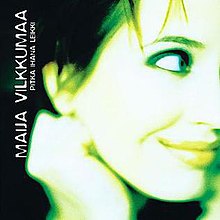Pitkä ihana leikki
| Pitkä ihana leikki | ||||
|---|---|---|---|---|
 |
||||
| Studio album by Maija Vilkkumaa | ||||
| Released | August 23, 1999 May 22, 2000 (Peltipainos) |
|||
| Genre | Pop rock | |||
| Length | 44:27 | |||
| Label | Warner Music Finland | |||
| Maija Vilkkumaa chronology | ||||
|
||||
| Alternative cover | ||||

Cover for the 2000 edition
Pitkä ihana leikki – peltipainos |
||||
| Singles from Pitkä ihana leikki | ||||
|
||||
Pitkä ihana leikki (in English: Long Sweet Game) is the debut album by Finnish pop rock singer-songwriter Maija Vilkkumaa, released by Warner Music in Finland in August 23, 1999. The songs are written and composed by Vilkkumaa.
Considered as a fresh new release on the Finnish pop rock scene by music critics, Pitkä ihana leikki was favorably critiqued for its imaginative lyrical content for which Vilkkumaa, according to her, partially got the inspiration from the 1980s Finnish rock band Dingo. The album debuted at number 12 on the Finnish Albums Chart, peaking third the next week, then going variably down spending there 29 weeks.Pitkä ihana leikki has sold over 38,000 copies to date in Finland, which has granted it a gold certification. In 2000, Vilkkumaa re-released the album under the title Pitkä ihana leikki – peltipainos ("Sheet Metal Edition"), with one extra song, "Peltirumpu".
Five singles were released from the album.
Pitkä ihana leikki was well received by music critics that thought it fulfilled the expectations set by its lead single "Satumaa-tango" played in early 1999. On the August 1999 volume of Finnish rock magazine Soundi, Jorma Jortikka gave the album four out of five stars, complimenting the album for "inventive melodies and perceptive lyrics", though recognizing "a few clumsy metaphores". He praised Pitkä ihana leikki for its "credibility", "overwhelming cheerfulness" and lack of aspirations for being overly artistic.
Likewise, Roope Lehtinen from City magazine gave the album four out of five stars. Noting the album's "strong lean on Dingo's tradition", Lehtinen praised the structures of the songs for "sense of drama", "catchy choruses" and "schlager-ish suppleness". Differing from Dingo's "metaphorical mazes", the lyrics are "sensible and brisk". Furthermore, Lehtinen credits the album for "outstanding self-irony" and "themes and narrators changing throughout the album" that make it stand out from average Finnish "self-centered" pop. However, he notes the album's own one-size-fits-all nature that manages to "please all listeners". Summing up the downsides of the "well-produced" record, he considers "Timantti" and "Salaa" "idle" and "Vähän ennen" too dance-ish.
...
Wikipedia
